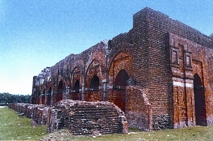Darasbari Mosque
Darasbari Mosque is the largest mosque in the Bangladesh part of gaur-lakhnauti, now in ruins. It is situated in the Darasbari quarter of the mediaeval city on the west side of the Chhota Sona-Kotwali Darwaza Road, at present a desolated area near the Indian border. The name Darasbari is derived from its being located within a darsbari (place of lesson or learning), pointing to the madrasa to the east of the mosque, separated by a large tank, forming a typical Muslim educational complex. According to its inscription, which is now preserved in the Indian Museum at Calcutta, Shamsuddin Abul Muzaffar Yusuf Shah built the mosque in 1479 AD.

The mosque, measuring externally 34m x 20.6m and internally 30.3m x 11.7m represents a typical mediaeval Bengali type Jami Masjid consisting of exposed red-tinged bricks with terracotta ornamentation both on the exterior and interior. It is at present without a roof and has a fallen verandah.
The mosque consists of two parts - a verandah in front in the east and the main prayer chamber to its west, the whole being divided longitudinally by a wide nave running east west. The roof of the prayer chamber consisted of three chauchala vaults over the nave - the middle one larger than the others - and nine inverted tumbler-shaped domes over each side of the nave, making eighteen in all.
Corresponding to these vaults and domes, there were a slightly smaller chauchala vault over the nave of the verandah and three smaller domes on each of its sides, making a grand total of four chauchala vaults and twenty-four domes, all now vanished. Brick piers carried the vaults and domes of the roof and stone pillars respectively, all now broken and free standing. Above the pillars sprang the pointed arches, which held the supporting pendentives filling up the corners of the square base of the dome.
An important feature of the mosque was the existence of a royal gallery (often erroneously described as a ladies gallery) in the northwest corner of the hall, approached from outside through a staired platform protected by armed guards at the entrance. It was this gallery, which marked this mosque, like several others in the city, as the Friday Congregational Mosque (Masjid-i-Juma). There was a gate to the north of the mosque, now reduced to debris. The mosque was strengthened in the corners by octagonal towers - those of the east now ruined, keeping only the traces to a certain height.
The ornamentation of the mosque was of most sumptuous character. The outside walls were patterned with vertical offset and inset designs with terracotta panels dominated by hanging motifs on their faces. The inside was patterned with brick settings noticed on the face of the arches and pendentives within. The ornamentation of the mihrabs, set against each of the bays, consisting of engrailed arches with frames of terracotta creepers, foliage, rosettes, spread out plants and hangings motifs are some of the finest specimens of this kind of decoration from Gaur-Lakhnauti. These terracottas are finer than other examples and appear to have been coated with a little glaze to make them look different and attractive. The walls extant to the west and south sides are now mostly the result of restoration work, which obliterated the original terracotta designs. An interesting ornamental motif of the curvilinear cornice was a terracotta flag placed in a running row affirming that the builder attended the mosque, and that he was the commander of the army and also of the faithful (amirul mu'minin).
The Darasbari Mosque at one time must have been one of the most beautiful examples of Sultanate mosques in Gaur-Lakhnauti. Built in the early years of the city, this mosque together with other contemporary examples initiated the 'Gauriya' style which spread to other parts of Bangala and came to be known as the independent Bengal style of the mediaeval period. [ABM Husain]
Bibliography ABM Husain (ed), Gawr-Lakhnawti, Dhaka, 1997.
